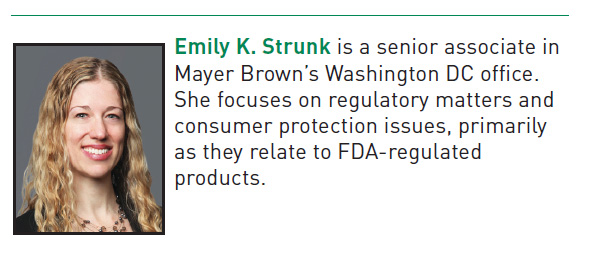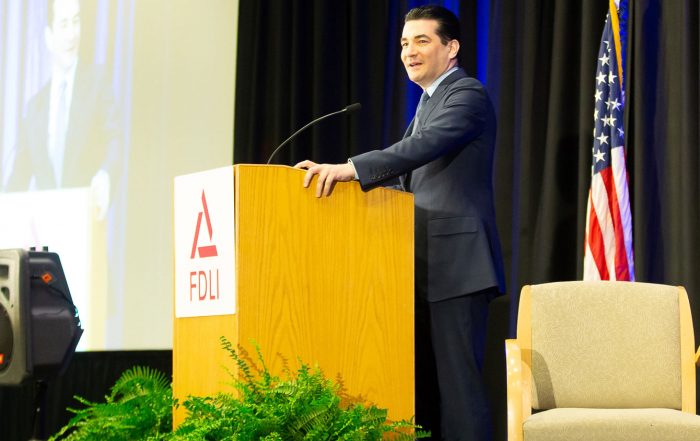
FDA in the New Administration: Policy and Enforcement Priorities for the Coming Year
by Emily K. Strunk
At this year’s FDLI Annual Conference, three of FDA’s top officials spoke to the agency’s policy and enforcement priorities for the coming year. FDA Commissioner Dr. Scott Gottlieb kicked off the conference as the keynote speaker, outlining the agency’s policy agenda for the coming year.1 Anna Abram, FDA’s Deputy Commissioner for Policy, Planning, Legislation, and Analysis, centered her remarks on how FDA is modernizing and streamlining regulations toward the goal of a more modern and efficient organization.2 FDA Chief Counsel Rebecca Wood closed out the first day, providing insights on the key issues in her office. Based on these remarks, this article explains what we can expect from FDA in the coming year on key policy issues and product areas. Consistent with previous FDA messaging since Commissioner Gottlieb came to the helm of the agency, the themes of these speeches were modernization, accounting for and adapting to new technology and science, and efficient processes, all while accomplishing the core mission of protecting public health.
Opioid Epidemic
 Commissioner Gottlieb opened by naming the opioid epidemic as the “biggest crisis facing the nation and FDA.” He noted that FDA is working on additional safeguards for dispensing opioids and initiatives to rationalize prescribing so that patients can avoid initial exposure, a prerequisite to addiction. Commissioner Gottlieb then promised the agency would have “more to say soon” on new measures to address the crisis. Chief Counsel Wood added that her office is prioritizing enforcement actions that could help temper opioid abuse. For example, by counseling on warning letters targeting companies illegally distributing opioids and developing innovative approaches to practices that could help reduce opioid addiction, such as enhanced prescribing and packaging.
Commissioner Gottlieb opened by naming the opioid epidemic as the “biggest crisis facing the nation and FDA.” He noted that FDA is working on additional safeguards for dispensing opioids and initiatives to rationalize prescribing so that patients can avoid initial exposure, a prerequisite to addiction. Commissioner Gottlieb then promised the agency would have “more to say soon” on new measures to address the crisis. Chief Counsel Wood added that her office is prioritizing enforcement actions that could help temper opioid abuse. For example, by counseling on warning letters targeting companies illegally distributing opioids and developing innovative approaches to practices that could help reduce opioid addiction, such as enhanced prescribing and packaging.
Drug Pricing
In what was perhaps the most controversial part of Commissioner Gottlieb’s remarks, he spoke at some length about drug pricing, ironically an area over which FDA does not have jurisdiction. He criticized “bad apples” in industry who “game the system” for maximum profit while failing to consider or adequately weigh the public health consequences of their actions. He called upon the moral obligations of manufacturers to serve the public health: “We’re not in the business of making widgets. We’re involved in a healthcare enterprise that hews to a higher calling.” He went on to say that the focus on profits and exclusivity was “shortsighted” and listed the various maneuvers he has seen drugmakers employ to “game” the system to achieve exclusivity beyond what Congress intended.
Although not within FDA’s jurisdiction, it certainly caught the audience’s attention when Commissioner Gottlieb mentioned the possibility of the federal government “reexamining” the safe harbor for drug rebates under the Anti- Kickback Statute as a means to “restore some semblance of reality between list and negotiated prices, and thereby boost affordability and competition.”
His remarks provided a nice tee-up for the Administration to introduce its “Blueprint to Lower Drug Prices and Reduce Out-of-Pocket Costs” just a week later. The blueprint will primarily be carried out by Health and Human Services Secretary Alex Azar and agencies outside of FDA. Among the potential actions listed in the blueprint, only a few would be carried out under FDA’s authority, and these mostly relate to increasing education about drug pricing and competition.
They are:
- requiring drugmakers to include list prices when advertising a drug;
- issuing a guidance document to prevent manufacturers “gaming” the regulatory processes by using shared system REMS to delay or block market entry by generic drug manufacturers and thereby reducing competition; and
- issuing new policies for promoting innovation and competition for biologics by improving the availability of biosimilars and educating stakeholders (clinicians, patients, and payors) on these alternatives.
Drugs
According to Commissioner Gottlieb, in the coming year, the Center for Drug Evaluation and Research (CDER) will seek to further modernize its regulatory review for new drugs by aligning drug development approaches more closely with the type of medicine being developed since FDA is seeing a rise in medicines that target the mechanisms giving rise to disease. This includes adapting CDER to the scientific changes by clustering review divisions, new and more integrated documentation procedures, and making the review process more team based. The ultimate goal is to make innovation easier and eliminate redundancies.
Chief Counsel Wood, while recognizing that compounded drugs serve a critical role in patient care, said FDA enforcement efforts will include “continued vigilance” on compounded drugs by prioritizing inspections for larger facilities that ship across state lines since the risk tends to be highest for products produced at these facilities. Her office is working closely with the Department of Justice to bring enforcement actions against compounders who fail to produce sterile drugs. She gave two examples of compounding pharmacies that recently entered into consent decrees after FDA determined that the drugs compounded at those pharmacies were produced under insanitary conditions.
Devices
Commissioner Gottlieb acknowledged that “FDA’s traditional medical product regulation isn’t always well suited to emerging technologies like digital health.” Last year, FDA put forth the Digital Health Innovation Action Plan, including the software pre-certification program. In the coming year, FDA intends to build on this approach to apply the same principles to other categories of devices that share rapid innovation cycles and high rates of iteration, such as certain molecular tests and artificial intelligence.
FDA is also shifting its medical device policy work to focus more on safety with the release of its Medical Device Safety Action Plan, which will support product developers who are creating products with the same or greater public health benefits, but improved safety profiles. Commissioner Gottlieb threw out several ways the agency might incentivize manufacturers to make safer medical devices, including a program, similar to the Breakthrough Device Program, that would give medical device developers working on safety issues special access to FDA. FDA is also considering allowing comparative safety claims.
Biologics
Reflecting on the potential for biologics to cure difficult-to-treat diseases, Commissioner Gottlieb said FDA will build on the comprehensive policy for regenerative products to establish a framework for advancing these therapies through a “flexible biologic review process.” At the same time, FDA will be enforcing against bad actors who exploit the promise of regenerative medicines with false claims or dangerous products.
He then spoke about the promise of gene therapy that arrived with the lentiviral vector, which he compared to “the inflection point when we first perfected the humanization of antibiotics.” The agency’s goal is to develop a flexible and risk-based review framework that ensures safety while efficiently advancing these novel products, which hold significant potential. Commissioner Gottlieb warned against creating a “dubious distinction” between small genetic changes in animals and larger genetic changes in animals, or altering genes in humans, saying that making exceptions to gene editing for animal drugs can only undermine the regulation of gene editing in humans and reduce confidence in the technology itself.
Food
Commissioner Gottlieb believes there is significant opportunity for improving nutrition and “using diet as a tool for reducing disability and death from chronic disease.” The agency is focusing on educating consumers about “healthy” foods so they can make better decisions about their diets. He hopes this will also incentivize food companies to make healthier products and to compete on voluntary, evidence-based claims that promote the healthfulness of a food, which FDA intends to make easier for food companies to do.
After briefly discussing menu labeling, and the then-imminent guidance document on the subject (which has since been issued), Commissioner Gottlieb moved on to food safety and the importance of aggressively moving forward with implementation of the Food Safety Modernization Act’s (FSMA) Produce Rule to prevent outbreaks such as the recent E. Coli infections from contaminated romaine lettuce—which not only have tragic consequences but are also bad for business. Working together with USDA, FDA should be ready to start inspections next year.
Tobacco
Turning to tobacco products, Commissioner Gottlieb believes that dramatically reducing smoking rates for combustible cigarettes will have the greatest public health impact above anything else the agency can do. However, he makes clear that while access to e-cigarettes may offer a less risky alternative to smoking combustibles, it “can’t come at the expense of a whole generation of youth becoming addicted to nicotine through these electronic products.” He stressed that the agency must regulate tobacco products in a way that “encourages innovation of less harmful products while still ensuring that all tobacco products are put through an appropriate series of regulatory gates to maximize any public health benefits and minimize the harms.”
Towards these policy objectives, FDA is considering several actions, including regulating the amount of nicotine in combustibles to reduce their addictiveness; issuing a guidance on toxicology testing that would be required for e-cigarettes to be approved as an over-the-counter drug; and re-evaluating the agency’s approach to developing nicotine replacement therapies. Deputy Commissioner Abram reiterated that reducing nicotine levels in combustibles could potentially reduce or eliminate the addictiveness of these products, and that any decision from FDA on this point will reflect the latest science.
The agency is also escalating enforcement actions and regulations to prevent tobacco use by kids. Commissioner Gottlieb in no uncertain terms warned: “Companies that know children are using their products are on notice. If you target kids, then we’re going to target you.” FDA will continue to heavily enforce against manufacturers who make their tobacco products attractive to kids and the retailers who sell to them. FDA is also taking a hard look at the flavors in cigarettes and cigarillos, which entice kids to initiate smoking. Chief Counsel Wood also took a hard line on this point, saying that her office is focused on enforcement against companies who make tobacco products dangerous to kids either by enabling or enticing tobacco use, and thus nicotine addiction. She also highlighted the dangers of liquid nicotine and recent actions against manufacturers who packaged liquid nicotine in containers that mimicked juice boxes and candy, actions that are especially concerning to FDA because very small amounts of liquid nicotine can be toxic to children.
Medical Counter Measures
Deputy Commissioner Abram spent a considerable amount of time discussing the importance of Medical Counter Measures (MCM), especially in the context of protecting the men and women serving in the U.S. military on foreign battlefields. Acting on legislation that authorizes the Department of Defense (DOD) and FDA to work together to expedite development and approval of biologics, drugs, and devices that address serious or life-threatening diseases or conditions of American military personnel, FDA and DOD are collaborating to expeditiously develop MCM. The agencies will jointly hold a workshop to discuss products needed to protect the health of our military, with the hopes that commercial developers can “identify opportunities to fulfill unmet medical needs for battlefield settings and other front-line conditions experienced by the men and women of the U.S. armed forces.”
Ensuring FDA’s Processes are Modern, Efficient, and Science-Based
In addition to commenting on some of the topics above, Deputy Commissioner Abram’s remarks discussed FDA’s broader strategy for “ensuring that FDA’s processes are as modern, efficient, and risk-based as possible across the agency, and how we’re applying this approach to federal, state, and international collaborations to advance medical product and food safety, and better support our Nation’s military personnel on the battlefield.” FDA is working towards this goal by modernizing its regulations, involving stakeholders in regulatory reform, and collaborating with public and private sectors.
FDA is modernizing and streamlining regulations in accordance with Executive Order (EO) 13777 5, which requires federal agencies to review its regulations and identify which ones are ripe for repeal, replacement, or modification. FDA is working with its stakeholders to carry out this agenda, which provides an opportunity to determine which regulations aren’t keeping up with the technology, science, or industry practice, and enhance how FDA fulfills its mission so that it fully reflects modern challenges and opportunities. The agency issued seven Requests for Information and, in response, received 240 comments, which are being considered as FDA implements EO 13777.
Second, in carrying out regulatory reform, FDA is working with industry to “identify promising areas for change and inform [its] endeavors.” Negotiations along these lines resulted in extended compliance dates to provide industry with clarity or efficiency when implementing the final rules on produce safety and nutrition labeling, respectively. FDA is also exploring the idea of amending the general biologics regulations to improve efficiency by adopting a risk-based approach to inspections.
Finally, FDA is actively working to increase collaborations that promote efficiency. In January, FDA entered into a formal agreement “to promote coordination and the streamlining of capacities and obligations on shared concerns and jurisdiction.” 6 Going forward the agencies are committed to working together in areas of dual jurisdiction, such as inspections, biotechnology, and produce safety. FDA continues to partner with foreign jurisdictions using Mutual Recognition Agreements to rely on another government’s inspection of an FDA-regulated manufacturer. This allows FDA to focus its inspections on higher risk areas. Lastly, FDA frequently works with states to more efficiently utilize resources. Deputy Commissioner Abram highlighted the current federal-state collaboration on the Drug Quality and Security Act, for which FDA is currently developing its policy and oversight program.
Constitutional Issues on FDA’s Radar
In addition to discussing enforcement efforts in specific product areas, as noted above, Chief Counsel Wood spoke on some larger legal issues of broad interest to FDA, regulated industry, and consumers. For example, she touched on the ever-hot topic of how the First Amendment applies to speech concerning FDA-regulated products and the emerging issue of whether federal preemption and federal preclusion may have a greater role in light of increased state regulation using non-identical rules.
Chief Counsel Wood reports her office’s First Amendment Working Group is “working hard to ensure that recent First Amendment developments in the courts are fully imprinted across the DNA of our office and our agency” and that they meet regularly to analyze First Amendment issues across a variety of FDA issues and matters. The First Amendment Working Group is currently working through important considerations; they concern refreshing regulations to reflect recent court decisions, issuing new guidance documents to enhance transparency, and improved training for FDA officials to be able to identify and consider First Amendment issues in their typical activities.
Regarding federal preemption and preclusion, Chief Counsel Wood said FDA is actively evaluating where its views and scientific conclusions may be useful to help determine whether state law actions should yield to or coexist with federal legal standards. As an example, she offered “circumstances in which state-law efforts to urge warnings with respect to a given matter—for example, that a particular substance causes cancer—will stand in sharp tension with the agency’s scientific judgment to the contrary or desire to take a risk-based, rather than a hazards-based, approach to regulation.”
International Mail Facilities
Commissioner Gottlieb closed with a comment on the International Mail Facilities, which inspects the mail with the goal of intercepting unapproved and illicit substances. FDA plans on substantially increasing its enforcement in this area. In the coming year, FDA plans to release data on the volume of these types of products that are intercepted and seek funds in the 2019 Federal Budget to improve inspections and forensic labs. He then noted that supporting the mission of the Office of Regulatory Affairs is one of his top priorities.
Conclusion
Commissioner Gottlieb, Deputy Commissioner Abram, and Chief Counsel Wood packed a lot into their combined 90 minutes of remarks. This is clearly an active time for FDA, in no small part because advances in science and technology are accelerating alongside increased globalization and connectedness. But with more advancements come more challenges and whether FDA can keep up with the pace of innovation and the challenges it presents remains to be seen. It is an exciting time to be watching FDA’s next moves and wondering what the agency may be reporting back on at next year’s FDLI Annual Conference.
- https://www.fda.gov/NewsEvents/Speeches/ucm606541.htm.
- https://www.fda.gov/NewsEvents/Speeches/ucm606682.htm.
- https://www.fda.gov/NewsEvents/Speeches/ucm606622.htm.
- https://www.hhs.gov/sites/default/files/AmericanPatientsFirst.pdf.
- https://www.whitehouse.gov/sites/whitehouse.gov/files/omb/memoranda/2017/M-17-23.pdf.
- https://www.fda.gov/NewsEvents/Newsroom/PressAnnouncements/ucm594424.htm.
Programs
Update Magazine
June/July 2018











